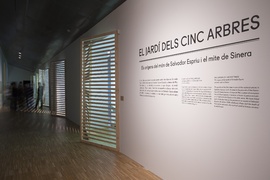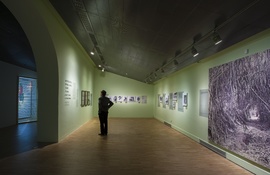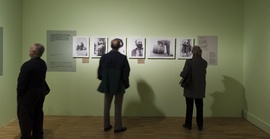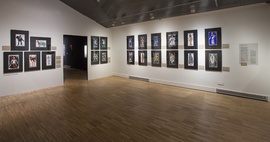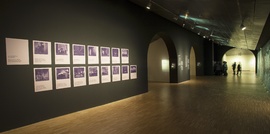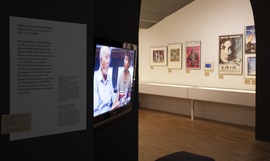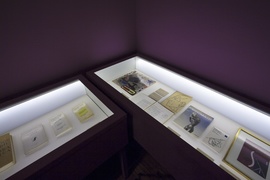Exhibition
Espriu. I looked upon this land
On the occasion of the centenary of the birth of writer Salvador Espriu, CCCB hosts the exhibition "Espriu: I looked upon this land", a journey through the life and works of one of the most prominent authors of Catalan literature. The exhibition includes a series of images, texts, objects and audio-visuals that create a perfect snapshot of the renowned author of Sinera.
On the occasion of Espriu Year — 2013 sees the commemoration of hundred years since the author’s birth — the CCCB is presenting this exhibition in coproduction with the Government of Catalonia.
The exhibition will be presented the world of Espriu and his historical and cultural environment.
The script allude three facets of Espriu’s personality, strategically arranged in a chronological and thematic way. First of all, the most private aspects. Next, the more social aspects. Finally, the more contemporary and current aspects of the world of Espriu. In such a way that the exhibition proposes a progressive opening from the personal world towards the collective world.
Within the second section on the more social aspect of the author (committed poet), the exhibition will approach Espriu’s relationship with the Catalans as a people, with special emphasis on the evolution of his view, on the stances he took in the face of the ups and downs of history and his ethical legacy to collectivity.
The starting point must be to ask: what does Espriu offer for readers of today? Based on this initial question, different aspects of his biography will be developed, along with his literary world, his career as a writer and the public repercussions of his work. The arrival point has to give a response to this initial question and underline the current relevance of Espriu, in the triple perspective proposed by the exhibition: the mythical and symbolic world, social transcendence, and untameable criticism.
1. THE GARDEN OF THE FIVE TREES. The origins of the world of Salvador Espriu and the myth of Sinera
- A BISHOP UNCLE AND A NOTARY FATHER . The Espriu-Castelló family, between Barcelona, Arenys de Mar and Viladrau.
The garden of the five trees is one of the mythical places in Salvador Espriu’s work. An area in the grounds of the Espriu-Castelló family home in Arenys de Mar, a place of recreation and childhood games, it became a haven of peace and place of meditation for Espriu in his later years. We have linked each of the five trees in the garden to an aspect of Salvador Espriu’s life before 1939: childhood, illness and the death of his brother and sister, the mythical world of Arenys, university and the war.
- A HAPPY CHILDHOOD UNDER THREAT. Illness and the death of his brother and sister.
The Espriu had five children. In 1920 the Espriu-Castelló children caught the measles, a highly contagious disease, which spread through the family. Although not a serious illness, it often brought complications. Salvador Espriu developed an empyema, an accumulation of pus in the pleural cavity. He had to undergo an extremely traumatic operation and his life hung in the balance for nearly ten months.
As a result of the measles, his sister, Maria Isabel, contracted an incurable disease, Huntington’s chorea, and she died in great pain on 1st January 1924. She was just 7 years old. At the end of July 1926, his elder brother, Francesc, who was just 14, fell into Arenys harbour. He developed a fistula that didn’t heal properly and led to a blood infection. He died in Arenys on 8th September.
- A SMALL LAND BETWEEN THE VINES AND THE SEA . The geographical and human substrate of the myth of Sinera.
Salvador Espriu i Castelló was born on 10th July 1913 in Santa Coloma de Farners, where his father was a notary. The family made their permanent home in Barcelona in 1915. Until he was 11, he spent the summers in Arenys de Mar, the hometown of his parents and forebears. During his father’s regular gatherings with his friends from the town, including the priest and the doctor, Espriu discovered a heroic yet grotesque past on which he built the myth of Sinera.
- YOUNG, ERUDITE AND SARCASTIC. Student of Ancient History and Law at the Autonomous University of Barcelona.
Espriu was part of the generation who lived through the golden days of Barcelona University before the Civil War. In October 1930, he enrolled at the Faculty of Law and the Faculty of Philosophy, Literature and Education. During this time, he met Bartomeu Rosselló-Pòrcel, Amàlia Tineo, Mercè Muntanyola and Lola Solà, who became his great friends. A cruise around the Mediterranean in the summer of 1933, which brought together the university’s elite pro-Republic students, was the great shared memory of those years. During this time, Espriu published his first books of narrative prose which were savaged by the critics.
2. MY PEOPLE AND I. Espriu, between defeat and public success
- FROM THE DEPTHS OF THE PIT. The early years of the Franco regime and the beginnings of cultural resistance
The outcome of the Civil War shattered Salvador Espriu’s world. The death of Bartomeu Rosselló-Pòrcel, in 1938, deprived him of his best friend and literary conspirator. His father’s death in 1940 meant he had to work as a lawyer to support his family. Espriu fully emerged as a poet and playwright during the post-Civil War period. The songs of Raimon and the stagings of his plays by the Escola d’Art Dramàtic Adrià Gual made him popular with the public. Espriu became a symbol of Catalan culture and resistance to the Franco regime.
- THE BULL-HIDE, SYMBOL. Poetry and the anti-Franco movement.
In La pell de brau (The Bull-hide, 1959), Espriu offers a reading of the links between the peoples of the Iberian Peninsula, inspired by Joan Maragall’s Himne ibèric (Iberian Hymn) and Pere Bosch Gimpera’s studies of ancient history. It emerged as a response to the views of the Castilian intellectuals from the generation of 98. The censor’s report didn’t detect the political charge of the book, which was published without any objections and became a symbol of the anti-Franco movement and cultural engagement.
- ESPRIU AND THE KABBALAH. Moral sustenance for difficult times.
Although the Kabbalah is a tradition based on the sacred Jewish book, the Torah, it embodied a secular form of mysticism until the middle of the 20th century. According to Rosa M. Delor, Espriu immersed himself in spirituality as a reaction against the dark world of interior exile where he had to live after the Civil War. In this section we have chosen ten excerpts from the book Final del laberint (The End of the Labyrinth, 1955) set out by Espriu according to the structure of the sephirothic tree: from darkness to light. The actors Josep Minguell and Carme Sansa read the excerpts.
- ESPRIU, ON STAGE. The productions of the Escola d’Art Dramàtic Adrià Gual.
Together with the Catalan singer-songwriter movement, the theatre made a decisive contribution to popularising the world of Salvador Espriu. The premiere of Primera història d’Esther (The Story of Esther) at the Palau de la Música, in 1957, by the Agrupació Dramàtica de Barcelona, directed by Jordi Sarsanedas, brought the work to a committed, loyal audience who sensed its underlying political message. The productions of the Escola d’Art Dramàtic Adrià Gual were the outcome of this initial experiment. Ricard Salvat, who had studied in Germany, saw the dramatic potential of Espriu’s works within the context of Brecht’s epic realism. Espriu’s work became the fulcrum of collective creativity involving young actors, writers and artists.
3. KEEPING WATCH ON POSTERITY. The transition, the burden of the myth and the national poet
- CONSTRUCTING AN IMAGE.
Espriu wasn’t fond of having his photograph taken, but he was the subject of a number of promotional and psychological portraits which appeared in the press and created a quasi-iconic image towards the end of his life. Grieving, spiritual, solemn, Espriu became the critical conscience of Catalan society, and linked it to an image of austerity and self-control. This section of the exhibition looks at the construction of Espriu’s image: from the portraits of the 1950s, that show his youthful strength, to the photographs of the 1960s, showing Espriu in his prime. The end of the Franco era brought about many changes in the political and cultural sphere. Party politics replaced people’s movements and unitary platforms. There was a crisis in the engaged culture of the post-Civil War period and an entertainment culture associated with the mass media emerged. Espriu played a prominent role during this period. His statements about the Catalan language and culture, which were disseminated in the press and on TV, adopted a quasi-oracular tone. Besieged by journalists, politicians and new writers, he had to shut himself away in order to write and rewrite his works.
4. THE GROTESQUE LABYRINTH. Espriu’s characters and their surprising relevance for our time
Of all the aspects of Salvador Espriu’s work, his most critical, ironic and even sarcastic side chimes best with our present-day sensibilities. Here is an Espriu who observes human frailties together with people’s selfishness and lack of solidarity and produces a many-sided, uncompromising and ruthless portrait of them. This is the grotesque labyrinth, inhabited by the wise men of Konilòsia (Spain), the gentry of Lavínia (Barcelona), the capital of Alfaranja (Catalonia), with their retinue of servants, and the people of Sinera (Arenys), with their glorious past and humble lives.
- “So, Mr. Director, we’re not going to get paid now either?”
“The subordinates” is a story in Ariadna al laberint grotesc (Ariadna in the Grotesque Labyrinth, 1935). A well-dressed, Catalan magnate, smoking a cigar, visits the workforce at his foundation to tell them that they won’t be paid this month. They all agree or look as if they agree. All of them, except Teresiana Cacao. The magnate blames the government and says, under his breath: When we’re independent... Animated by Marcel Pié, this scene is still surprisingly pertinent.
- “A singular, but simple labyrinth, among outlandish voices and figures.”
Fifteen characters from Espriu’s works we have come across in different parts of this exhibition, drawn and animated by Laboratòrium. Nicolau the bear, who danced in ragged clothes through the streets of Sinera, and the delicate Queen Esther; Crisant Baptista Mestres, praising the disciples; the teacher Ulrika Thöus, who spends her life counting spermatozoa for her research in genetics; Teresa Vallalta – from one of Espriu’s most tragi-comic stories Tereseta-que-baixava-les-escales (Tereseta-coming-down-the-stairs) – longing for the glorious past of her mansion; and the Ginebredes, who are now ruined, forgotten and have been crushed by the post-War years.
5. SPACE FOR DOCUMENTATION, CONSULTATIONS AND WORKSHOPS
This is a space to explore aspects of Salvador Espriu included in the exhibition and hold the workshops that CCCB Education has designed for schools and families. It also includes a display case with first editions of Espriu’s work and an editorial history of some of the publications.
Related contents
Salvador Espriu: La salvació per la paraula
Lecture by Ramon Riera and recital by Jordi Brau




